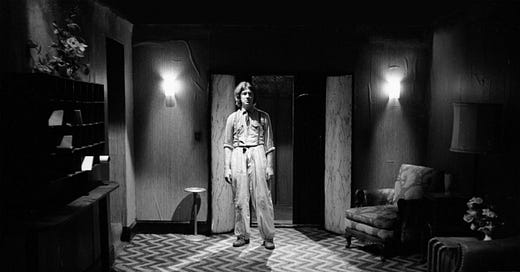A shorter version of this piece first appeared in a round table hosted by Dirt ☼
"Finally, I sat in front of a curious man, beaming with light, speaking words from another era, making me laugh and feel at ease. How did he even "see me" when I was so well hidden, and l'd even lost sight of myself?!" — Naomi Watts
David Lynch loved light bulbs and he loved lamps—on Lynch’s screen lamps flicker, spotlight, and strobe when a mood goes awry; his photosensitivity was attuned to the filaments of emotion, how a feeling can change with a filter.
"Now, we walk away," says Lynch, in his 2003 film Lamp, in which, for 31 minutes, he builds a two-toned lamp—a sculpture—made with a gauze-wrapped pole and yellow and grey fix-all plaster. "Take a look at that color in this afternoon light. It's summertime." As he rifles through his paint box, he names each color as he pulls them out. On the last one, he grins big: "Lamp Black."
Lynch also loved Los Angeles. He especially loved the lighting, he found it "bright and smooth," and that it filled him with "the feeling that all possibilities are available," he sensed a type of spiritualism in the way particles spread across the sprawl. A moth drawn to bright light in stretches of darkness.
Sconces, pendants, swags, floor and table lamps; often a lamp is the single source of light in a scene. A single wall light in a wash of green hallway in Inland Empire (2006) or a bedside lamp in Lost Highway (1997). Lynch's lamps also register a sense of place: the cholla branch lamp and stitched rawhide lampshades that pop up throughout Twin Peaks (1990-91), are decor staples of the U.S. West and its hotel rooms, bank lobbies, and family homes.
In a Lynch movie, lamps are sometimes props or even sculptural objects, but they also take and hold emotional temperatures while simultaneously and quite literally, holding the attention of distressed or bewildered viewers. For one, the delicate antique bedside lamp from Occupied Japan in Laura Palmer's bedroom shares screen space with BOB's sick grin. This lamp is a counterweight to the violence in the composition, offering a delicate, girl-like warmth in response to the tension.
In a scene from Fire Walk with Me (1992), a heavy-looking Romanesque brass lamp with a twisted rattan shade pulls focus from the menacing silhouette of Leland Palmer as he turns the corner, slotting himself into view. It wasn't just light or lamps, but their shadowy absence, too. It wasn't just a sparse shot anchored by endpoints—it's space for the horror of one's own imagination.
Keep reading with a 7-day free trial
Subscribe to West Ends to keep reading this post and get 7 days of free access to the full post archives.






